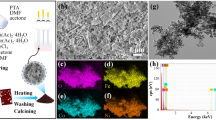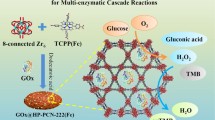Abstract
Recently, metal-organic framework (MOF)-based multienzyme systems integrating different functional natural enzymes and/or nanomaterial-based artificial enzymes are attracting increasing attention due to their high catalytic efficiency and promising application in sensing. Simple and controllable integration of enzymes or nanozymes within MOFs is crucial for achieving efficient cascade catalysis and high stability. Here, we report a facile electrochemical assisted biomimetic mineralization strategy to prepare an artificial multienzyme system for efficient electrochemical detection of biomolecules. By using the GOx@Cu-MOF/copper foam (GOx@Cu-MOF/CF) architecture as a proof of concept, efficient enzyme immobilization and cascade catalysis were achieved by in situ encapsulation of glucose oxidase (GOx) within MOFs layer grown on three-dimensional (3D) porous conducting CF via a facile one-step electrochemical assisted biomimetic mineralization strategy. Due to the bio-electrocatalytic cascade reaction mechanism, this well-designed GOx@Cu-MOF modified electrode exhibited superior catalytic activity and thermal stability for glucose sensing. Notably, the activity of GOx@Cu-MOF/CF still remained at ca. 80% after being incubated at 80 °C. In sharp contrast, the activity of the unprotected electrode was reduced to the original 10% after the same treatment. The design strategy presented here may be useful in fabricating highly stable enzyme@MOF composites applied for efficient photothermal therapy and other platform under high temperature.

Similar content being viewed by others
References
Bornscheuer, U. T.; Huisman, G. W.; Kazlauskas, R. J.; Lutz, S.; Moore, J. C.; Robins, K. Engineering the third wave of biocatalysis. Nature2012, 485, 185–194.
Turner, N. J. Directed evolution drives the next generation of biocatalysts. Nat. Chem. Biol.2009, 5, 567–573.
Trifonov, A.; Tel-Vered, R.; Fadeev, M.; Willner, I. Electrically contacted bienzyme-functionalized mesoporous carbon nanoparticle electrodes: Applications for the development of dual amperometric biosensors and multifuel-driven biofuel cells. Adv. Energy Mater.2015, 5, 1401853.
Geng, P. B.; Zheng, S. S.; Tang, H.; Zhu, R. M.; Zhang, L.; Cao, S.; Xue, H. G.; Pang, H. Transition metal sulfides based on graphene for electrochemical energy storage. Adv. Energy Mater.2018, 8, 1703259.
Chen, W. H.; Vázquez-González, M.; Zoabi, A.; Abu-Reziq, R.; Willner, I. Biocatalytic cascades driven by enzymes encapsulated in metal-organic framework nanoparticles. Nat. Catal.2018, 1, 689–695.
Feng, D. W.; Liu, T. F.; Su, J.; Bosch, M.; Wei, Z. W.; Wan, W.; Yuan, D. Q.; Chen, Y. P.; Wang, X.; Wang, K. C. et al. Stable metal-organic frameworks containing single-molecule traps for enzyme encapsulation. Nat. Commun.2015, 6, 5979.
Zhang, C.; Wang, X. R.; Hou, M.; Li, X. Y.; Wu, X. L.; Ge, J. Immobilization on metal-organic framework engenders high sensitivity for enzymatic electrochemical detection. ACS Appl. Mater. Interfaces2017, 9, 13831–13836.
Wang, Q. Q.; Zhang, X. P.; Huang, L.; Zhang, Z. Q.; Dong, S. J. GOx@ZIF-8 (NiPd) nanoflower: An artificial enzyme system for tandem catalysis. Angew. Chem., Int. Ed.2017, 56, 16082–16085.
Wei, H.; Wang, E. K. Nanomaterials with enzyme-like characteristics (nanozymes): Next-generation artificial enzymes. Chem. Soc. Rev.2013, 42, 6060–6093.
Lian, X. Z.; Chen, Y. P.; Liu, T. F.; Zhou, H. C. Coupling two enzymes into a tandem nanoreactor utilizing a hierarchically structured MOF. Chem. Sci. 2016, 7, 6969–6973.
Lian, X. Z.; Erazo-Oliveras, A.; Pellois, J. P.; Zhou, H. C. High efficiency and long-term intracellular activity of an enzymatic nanofactory based on metal-organic frameworks. Nat. Commun.2017, 8, 2075.
Zheng, S. S.; Xue, H. G.; Pang, H. Supercapacitors based on metal coordination materials. Coord. Chem. Rev.2018, 373, 2–21.
Vijayalakshmi, A.; Karthikeyan, R.; Berchmans, S. Nonenzymatic reduction of hydrogen peroxide produced during the bioelectrocatalysis of glucose oxidase on urchin-like nanofibrillar structures of Cu on Au substrates. J. Phys. Chem. C2010, 114, 22159–22164.
Lee, S.; Ringstrand, B. S.; Stone, D. A.; Firestone, M. A. Electrochemical activity of glucose oxidase on a poly(ionic liquid)-Au nanoparticle composite. ACS Appl. Mater. Interfaces2012, 4, 2311–2317.
Ma, W. J.; Jiang, Q.; Yu, P.; Yang, L. F.; Mao, L. Q. Zeolitic imidazolate framework-based electrochemical biosensor for in vivo electrochemical measurements. Anal. Chem.2013, 85, 7550–7757.
Zhang, Y. F.; Ge, J.; Liu, Z. Enhanced activity of immobilized or chemically modified enzymes. ACS Catal.2015, 5, 4503–4513.
Doonan, C.; Ricco, R.; Liang, K.; Bradshaw, D.; Falcaro, P. Metal-organic frameworks at the biointerface: Synthetic strategies and applications. Acc. Chem. Res.2017, 50, 1423–1432.
Lian, X. Z.; Fang, Y.; Joseph, E.; Wang, Q.; Li, J. L.; Banerjee, S.; Lollar, C.; Wang, X.; Zhou, H. C. Enzyme-MOF (metal-organic framework) composites. Chem. Soc. Rev.2017, 46, 3386–3401.
Mehta, J.; Bhardwaj, N.; Bhardwaj, S. K.; Kim, K. H.; Deep, A. Recent advances in enzyme immobilization techniques: Metal-organic frameworks as novel substrates. Coord. Chem. Rev.2016, 322, 30–40.
Gkaniatsou, E.; Sicard, C.; Ricoux, R.; Benahmed, L.; Bourdreux, F.; Zhang, Q.; Serre, C.; Mahy, J. P.; Steunou, N. Enzyme encapsulation in mesoporous metal-organic frameworks for selective biodegradation of harmful dye molecules. Angew. Chem., Int. Ed.2018, 57, 16141–16146.
Hanefeld, U.; Gardossi, L.; Magner, E. Understanding enzyme immobilisation. Chem. Soc. Rev.2009, 38, 453–468.
Kempahanumakkagari, S.; Kumar, V.; Samaddar, P.; Kumar, P.; Ramakrishnappa, T.; Kim, K. H. Biomolecule-embedded metal-organic frameworks as an innovative sensing platform. Biotechnol. Adv.2018, 36, 467–481.
Gkaniatsou, E.; Sicard, C.; Ricoux, R.; Mahy, J. P.; Steunou, N.; Serre, C. Metal-organic frameworks: A novel host platform for enzymatic catalysis and detection. Mater. Horiz.2017, 4, 55–63.
Chen, L. N.; Zhan, W. W.; Fang, H. H.; Cao, Z. M.; Yuan, C. F.; Xie, Z. X.; Kuang, Q.; Zheng, L. S. Selective catalytic performances of noble metal nanoparticle@MOF composites: The concomitant effect of aperture size and structural flexibility of MOF matrices. Chem.—Eur. J.2017, 23, 11397–33403.
Chen, L. N.; Zhang, X. B.; Zhou, J. H.; Xie, Z. X.; Kuang, Q.; Zheng, L. S. A Nano-reactor based on PtNi@metal-organic framework composites loaded with polyoxometalates for hydrogenation-esterification tandem reactions. Nanoscale2019, 11, 3292–3299.
Xu, W. Q.; Jiao, L.; Yan, H. Y.; Wu, Y.; Chen, L. J.; Gu, W. L.; Du, D.; Lin, Y. H.; Zhu, C. Z. Glucose oxidase-integrated metal-organic framework hybrids as biomimetic cascade nanozymes for ultrasensitive glucose biosensing. ACS Appl. Mater. Interfaces2019, 11, 22096–22101.
Chen, G. S.; Huang, S. M.; Kou, X. X.; Wei, S. B.; Huang, S. Y.; Jiang, S. Q.; Shen, J.; Zhu, F.; Ouyang, G. F. A convenient and versatile aminoacid-boosted biomimetic strategy for the nondestructive encapsulation of biomacromolecules within metal-organic frameworks. Angew. Chem., Int. Ed.2019, 58, 1463–1467.
Cowan, D. A.; Fernandez-Lafuente, R. Enhancing the functional properties of thermophilic enzymes by chemical modification and immobilization. Enzyme Microb. Technol.2011, 49, 326–346.
Liang, K.; Ricco, R.; Doherty, C. M.; Styles, M. J.; Bell, S.; Kirby, N.; Mudie, S.; Haylock, D.; Hill, A. J.; Doonan, C. J. et al. Biomimetic mineralization of metal-organic frameworks as protective coatings for biomacromolecules. Nat. Commun.2015, 6, 7240.
Li, P.; Modica, J. A.; Howarth, A. J.; Vargas L, E.; Moghadam, P. Z.; Snurr, R. Q.; Mrksich, M.; Hupp, J. T.; Farha, O. K. Toward design rules for enzyme immobilization in hierarchical mesoporous metal-organic frameworks. Chem2016, 1, 154–169.
Chen, L. N.; Wang, T.; Xue, Y. K.; Zhou, X.; Zhou, J. H.; Cheng, X. Q.; Xie, Z. X.; Kuang, Q.; Zheng, L. S. Rationally armoring PtCu alloy with metal-organic frameworks as highly selective nonenzyme electrochemical sensor. Adv. Mater. Interfaces2018, 5, 1801168.
Mohammad, M.; Razmjou, A.; Liang, K.; Asadnia, M.; Chen, V. Metal-organic-framework-based enzymatic microfluidic biosensor via surface patterning and biomineralization. ACS Appl. Mater. Interfaces2019, 11, 1807–1820.
Qiu, Q. M.; Chen, H. Y.; Wang, Y. X.; Ying, Y. B. Recent advances in the rational synthesis and sensing applications of metal-organic framework biocomposites. Coord. Chem. Rev.2019, 387, 60–78.
Zhang, Y. F.; Hess, H. Toward rational design of high-efficiency enzyme cascades. ACS Catal.2017, 7, 6018–6027.
Wang, M.; Mohanty, S. K.; Mahendra, S. Nanomaterial-supported enzymes for water purification and monitoring in point-of-use water supply systems. Acc. Chem. Res.2019, 52, 876–885.
Campagnol, N.; Stassen, I.; Binnemans, K.; De Vos, D. E.; Fransaer, J. Metal-organic framework deposition on dealloyed substrates. J. Mater. Chem. A2015, 3, 19747–19753.
Li, W. J.; Tu, M.; Cao, R.; Fischer, R. A. Metal-organic framework thin films: Electrochemical fabrication techniques and corresponding applications &; perspectives. J. Mater. Chem. A2016, 4, 12356–12369.
Campagnol, N.; Van Assche, T. R. C.; Li, M. Y.; Stappers, L.; Dincă, M.; Denayer, J. F. M.; Binnemans, K.; De Vos, D. E.; Fransaer, J. On the electrochemical deposition of metal-organic frameworks. J. Mater. Chem. A2016, 4, 3914–3925.
Li, Z. X.; Xia, H.; Li, S. M.; Pang, J. F.; Zhu, W.; Jiang Y. B. In situ hybridization of enzymes and their metal-organic framework analogues with enhanced activity and stability by biomimetic mineralisation. Nanoscale2017, 9, 15298–15302.
Du, Y. J.; Gao, J.; Liu, H. J.; Zhou, L. Y.; Ma, L.; He, Y.; Huang, Z. H.; Jiang, Y. J. Enzyme@silica nanoflower@metal-organic framework hybrids: A novel type of integrated nanobiocatalysts with improved stability. Nano Res.2018, 11, 4380–4389.
Li, Z. X.; Ding, Y.; Li, S. M.; Jiang, Y. B.; Liu Z.; Ge J. Highly active, stable and self-antimicrobial enzyme catalysts prepared by biomimetic mineralization of copper hydroxysulfate. Nanoscale2016, 8, 17440–17445.
Soganci, T.; Baygu, Y.; Kabay, N.; Gök, Y.; Ak, M. Comparative investigation of peripheral and nonperipheral zinc phthalocyanine-based polycarbazoles in terms of optical, electrical, and sensing properties. ACS Appl. Mater. Interfaces2018, 10, 21654–21665.
Wang, H. W.; Lang, Q. L.; Li, L.; Liang, B.; Tang, X. J.; Kong, L. R.; Mascini, M.; Liu, A. H. Yeast surface displaying glucose oxidase as whole-cell biocatalyst: Construction, characterization, and its electrochemical glucose sensing application. Anal. Chem.2013, 85, 6107–6112.
Yang, Y.; Zhang, R. Q.; Zhou, B. N.; Song, J. Y.; Su, P.; Yang, Y. High activity and convenient ratio control: DNA-directed coimmobilization of multiple enzymes on multifunctionalized magnetic nanoparticles. ACS Appl. Mater. Interfaces2017, 9, 37254–37263.
Zhao, M. G.; Li, Z. L.; Han, Z. Q.; Wang, K.; Zhou, Y.; Huang, J. Y.; Ye, Z. Z. Synthesis of mesoporous multiwall ZnO nanotubes by replicating silk and application for enzymatic biosensor. Biosens. Bioelectron.2013, 49, 318–322.
Acknowledgements
This work was supported by the National Key Research and Development Program of China (Nos. 2017YFA0206500 and 2017YFA0206801), the National Basic Research Program of China (No. 2015CB932301), and the National Natural Science Foundation of China (Nos. 21671163, 21721001, and J1310024).
Author information
Authors and Affiliations
Corresponding author
Electronic Supplementary Material
12274_2019_2548_MOESM1_ESM.pdf
One-step synthesis of thermally stable artificial multienzyme cascade system for efficient enzymatic electrochemical detection
Rights and permissions
About this article
Cite this article
Cheng, X., Zhou, J., Chen, J. et al. One-step synthesis of thermally stable artificial multienzyme cascade system for efficient enzymatic electrochemical detection. Nano Res. 12, 3031–3036 (2019). https://doi.org/10.1007/s12274-019-2548-8
Received:
Revised:
Accepted:
Published:
Issue Date:
DOI: https://doi.org/10.1007/s12274-019-2548-8




